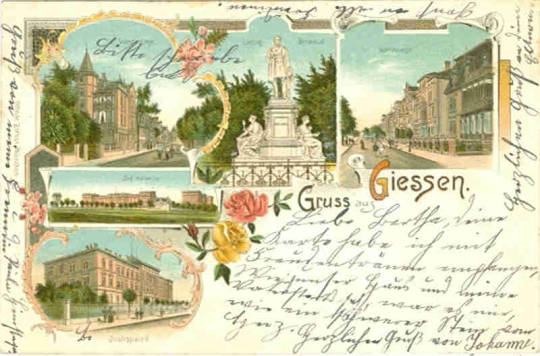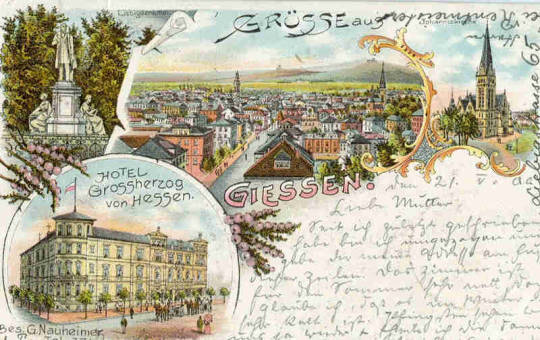#Giessen
Explore tagged Tumblr posts
Text

The Lilly house : Justus Liebig Botanic Garden. Giessen
18 notes
·
View notes
Text
Nyxotype pushes boundaries with new track inspired by classic literature
Drawing inspiration from the infamous python character from Rudyard Kipling’s The Jungle Book, Kaa is the latest single from Giessen, Germany’s nyxotype. Continue reading Nyxotype pushes boundaries with new track inspired by classic literature
0 notes
Text
To nie ja!
0 notes
Text

GIESSEN - HESSEN / GERMANY
0 notes
Text




0 notes
Photo

New Post has been published on https://www.modeonlineshoppen.de/filialen/tk-maxx-giessen-seltersweg-1-35390/
TK Maxx Giessen - Seltersweg 1, 35390
0 notes
Link
1 note
·
View note
Photo

Frühling in Wetzlar an der Burg Kalsmunt. #giessen #wetzlar #garbenheim #lahn #mittelhessen #ldk #lahndillkreis #lahndillbergland #hessen #nature #landschaftsfotografie #landschaft #natur #naturfotografie #naturfoto #landscapephotography #picoftheday #nature #naturephotography #explore #fotografie #photography #getoutdoors #exploremore #letsgosomewhere #frühling #natures_moods #mood #moody #spring (hier: Wetzlar, Germany) https://www.instagram.com/p/CqH04lGNNCX/?igshid=NGJjMDIxMWI=
#giessen#wetzlar#garbenheim#lahn#mittelhessen#ldk#lahndillkreis#lahndillbergland#hessen#nature#landschaftsfotografie#landschaft#natur#naturfotografie#naturfoto#landscapephotography#picoftheday#naturephotography#explore#fotografie#photography#getoutdoors#exploremore#letsgosomewhere#frühling#natures_moods#mood#moody#spring
0 notes
Text
Hotel in Giessen schnell finden – Rooms24

Buchen Sie jetzt das beste Hotel in Giessen! - Rooms24
#deutschland#giessen#rooms24#ferienvermietung#ferienhaus#ferienwohnung#monteurzimmer#gästezimmer#unterkünfte#unterkunft#privat unterkünfte#hotelangeboten#luxury hotel#hotels#hotel#hotels and resorts
0 notes
Photo

Happy birthday, love of my life, @eintrachtfrankfurt. Und übrigens auch allen Frauen einen schönen Weltfrauentag. 😎 ◾ #SGE #weltfrauentag #worldwomensday #womensday #women #woman #happybirthday #happy #birthday #Eintracht #Frankfurt #EintrachtFrankfurt #FrankfurtAmMain #Hessen #Giessen #Wetzlar #Marburg #love #Liebe #Work #selfie #me #Geburtstag #AllesGute (hier: Gießen, Germany) https://www.instagram.com/p/CpiOxN1t7-T/?igshid=NGJjMDIxMWI=
#sge#weltfrauentag#worldwomensday#womensday#women#woman#happybirthday#happy#birthday#eintracht#frankfurt#eintrachtfrankfurt#frankfurtammain#hessen#giessen#wetzlar#marburg#love#liebe#work#selfie#me#geburtstag#allesgute
0 notes
Text

Mücke, Hesse.
79 notes
·
View notes
Link
1 note
·
View note
Text
Aluhut-Träger und Fahreignung
Über #Aluhut-Träger aus #Hessen und deren Fahreignung. via @udovetter & Co.
Den berühmten Aluhut-Träger gibt es wirklich. In Hessen. Dort versuchte sich ein Mann gegen „EMW-Terroristen“ zu wehren, sprang durch Vorgärten und führte er in seinem Auto eine mit Alufolie umwickelte Bleischale und eine Bleiweste mit sich. Das fanden Polizisten bei einer Kontrolle merkwürdig, die sp��tere Korrespondenz des Mannes mit der Führerscheinstelle sorgte für den juristischen…

View On WordPress
0 notes
Text

GIESSEN - GERMANY / Hessen
0 notes
Text

#salonlocal#giessen#hairsalon#liebigstraße72#creativedirector#Friseur#friseursalongiessen#friseurgießen#friseuregiessen#männer#männergesichter
0 notes
Text

THURSDAY HERO: Mildred Harnack
Mildred “Mili” Harnack was a writer and academic from Wisconsin who moved to Berlin with her German husband in 1930. As Hitler rose to power, Mili created the largest resistance group in Nazi Germany and was targeted for execution by the Fuhrer himself.
Mili was born Mildred Fish in Milwaukee in 1902. Her father William was a teacher, and her mother Georgina was an activist for women’s suffrage. Mili had a natural facility with languages, and was fluent in German by the time she reached adulthood. Throughout her life, Mili loved German literature and culture. She attended the University of Wisconsin in Madison, where she majored in English literature. Mili lived in a rooming house popular with writers, and worked as a film and drama critic for a local newspaper.
After receiving her BA, Mili went on to earn an MA in English in 1925. The next year she moved back to Milwaukee and worked as a lecturer at the Milwaukee State Normal School (now the University of Wisconsin – Milwaukee.) She met Arvid Harnack, a German economist and lawyer who was studying at the university on a Rockefeller fellowship. Arvid was from a prominent family of German intellectuals. After a whirlwind love affair, they were married in August 1926 at her brother’s farm. Arvid’s fellowship ended and he returned to Germany, followed by Mili the year later, after she completed a teaching session at Goucher College in Baltimore.
In Germany, Mili worked on her doctoral thesis and lectured at universities in German cities Jena and Giessen. The country was plunging deeper into political turmoil, and the Nazi party was rising to power amid the chaos. More than half of Mili’s students were outspoken Nazis. She moved to Berlin in 1930 to be with her husband, and began working as an assistant lecturer in English and American literature at the University of Berlin. Mili lectured about her favorite English and American writers including Ralph Waldo Emerson, Walt Whitman, Thomas Hardy and George Bernard Shaw. She was so popular with students that in just a year and a half, enrollment in the class tripled.
Mili connected with other American expatriates in Berlin and formed a literary salon where anti-Nazi academics and intellectuals could express themselves freely. By 1934, the Nazi secret police were everywhere and the salon was disbanded. Fellow ex-pat Martha Dodd, a close friend of Mili’s, later described her Berlin salon as “the last of the meager remnants of free thought.” Many of those who had participated in the salons continued to meet in the Harnacks’ living room but instead of discussing literature, they planned anti-Nazi political activism
Meanwhile, Mili achieved renown as a writer. She published essays in prominent German literary journals until the mid-30’s, when magazines started to print only “approved opinions” (in support of Hitler). She was able to continue working as a translator, and her German-language translation of Irving Stone’s biography of Vincent van Gogh, Lust for Life, was published in 1936.
Mili returned to the U.S. on a book tour in 1937, and her old friends were shocked at the drastic change in her personality. Earlier she had been friendly and easy-going, but four years living under Nazi rule made Mili anxious, stiff and guarded. She’d had to wear a metaphorical mask to survive in the totalitarian German state, and couldn’t shed the mask even when she left Europe. Mili’s family urged her to stay in the U.S. but she was determined to return to her husband and her political activism group, now called “The Circle.”
Mili’s unassuming manner combined with an extremely sharp intellect enabled her to penetrate the highest circles of German politics and diplomacy. She used these connections to get exit and travel visas for Jewish friends and colleagues, among them prominent publisher Max Tau. Mili also surreptitiously gleaned information from highly placed contacts, which she transmitted to fellow members of the resistance.
Mildred was fired from her teaching job at the University of Berlin because of her political beliefs, and she began teaching at night school, where her students were mostly working class or unemployed. She recruited many of them to join The Circle. The group published anti-Nazi leaflets, written by Mildred, and secretly left stacks of them in public places throughout the city.
German intelligence called them “the Red Orchestra” and falsely smeared them as communists working for the Soviets. Undeterred, the group increased their activities and cooperated with other resistance units. Around this time Mili wrote, “I saw it clearly before my eyes. From then on our work not only implies the risk of losing our freedom, from now on death was a possibility.” Led by Mili, The Circle became the largest resistance group in Nazi Germany. They incited civil disobedience against the Nazi regime, documented Nazi atrocities, and transmitted military intelligence to the Allies.
In the summer of 1942, the Nazis intercepted radio transmissions that revealed the identity of prominent resistance fighters including the Harnacks. On September 7, Mili and Arvid were arrested by the Gestapo and imprisoned. Arvid was tried by the Reich Military Tribunal and sentenced to death on December 19. He was hanged three days later at Plotzensee Prison.
Mili languished in a squalid prison cell for months, where she was tortured and contracted tuberculosis. She went on trial and was sentenced to six years in prison. However, Hitler heard about the American woman who fought so effectively against his regime, and he ordered a new trial for Mili. The kangaroo court delivered a pre-determined death sentence, and at Hitler’s explicit request Mili was beheaded by guillotine on February 16, 1943. Her last words were, “And I have loved Germany so much!” After her execution, Mili’s body was given to an anatomy professor at Humboldt University to dissect for research. After he finished, he gave the rest of her remains to a friend of hers, who had Mili buried in Zehlendorf Cemetery in Berlin.
The only writing that survived from her time in prison were a few translated lines from Goethe: “In all the frequent troubles of our days/A God gave compensation – more his praise/In looking sky-and heavenward as duty/In sunshine and in virtue and in beauty.”
Mildred’s brave actions and tragic death have not been forgotten. In Berlin, a street and a school are named for her, and in her native Wisconsin schools observe Mildred Fish Harnack Day. The University of Wisconsin-Madison hosts an annual Mildred Fish-Harnack Human RIghts and Democracy Lecture, and a sculpture of Mili was unveiled in Madison in 2019.
For fighting Hitler at the cost of her own life, we honor Mildred Harnack as this week’s Thursday Hero.
Image: Gestapo mug shots of Mildred taken after her arrest in 1942.
90 notes
·
View notes